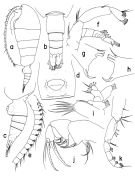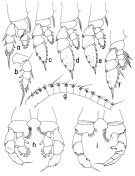|
|
 |
Fiche d'espèce de Copépode |
|
|
Calanoida ( Ordre ) |
|
|
|
Arietelloidea ( Superfamille ) |
|
|
|
Heterorhabdidae ( Famille ) |
|
|
|
Neorhabdus ( Genre ) |
|
|
| |
Neorhabdus brevicornis Park, 2000 (F,M) | |
| | | | | | | Ref.: | | | Park, 2000 (p.64, figs.F,M, Rem.) |  issued from : T. Park in Bull. Scripps Inst. Oceanogr. Univ. California, San Diego, 2000, 31. [p.190, Fig.38]. Female: a, habitus (left side); b, c, urosome (dorsal, left, respecyively); d, genital somite (ventral); e, segments 1-12 of left A1 (ventral); f, left A2 (posterior); g, masticatory edge of right Md (posterior); h, masticatory edge of left Md (posterior); i, left Mx1 (posterior); j, left Mx2 (posterior); k, right Mxp (anterior). Nota: Prosome about 3/4 length of body and about 2.8 times as long as urosome. Cephalosome about 2/5 length of prosome. Rostrum small bearing 2 filaments. Urosome slightly longer than 1/4 length of body. Ventrally, genital operculum typically with a width-length ratio of 100:63 and about 1/2 as wide as somite itself. Genital field with about 15 pores on each side and 2 pores on anterior side. 2nd urosomal somite about 3/5 length of genital somite and about 1.1 times length of 3rd urosomal somite. Anal segment about 4/5 length of 3rd urosomal somite. Combined lengths of anal segment and left caudal ramus about 1.2 times length of genital somite. Left caudal ramus longer than right, its 4th marginal seta about twice lenthh of body. Dorsally, caudal rami each with 3 or 4 pores and with appendicular setae of similar size. Laterally, anal segment (Fig.38-c) with 2 pores, left caudal ramus with 3 pores. A1 reaching about posterior end of prosome. Four lobes of 1st segment (Fig.38-e) with 1+2+2+2 setae and 0+1+1+3 aesthetes. Segments 2 to 19 each with 2 setae (1 middle and 1 distal) as in N. latus female. Number of aesthetes : 2 on 2nd segment, 3 on 3rd segment, 2 on 4th segment, 3 on 5th segment, 2 on each of 6th to 9th, 1 on each of 10th to 19th. Aesthetes better developed than ib N. latus. A2, Md, Mx1, Mx2 and Mxp similar to those of N. latus except for some characteristics.
|
 issued from : T. Park in Bull. Scripps Inst. Oceanogr. Univ. California, San Diego, 2000, 31. [p.191, Fig.39]. Female: a, P1 (anterior); b, P1 (endopod omitted), posterior); c, P2 (anterior); d, P3 (anterior); e, P4 (anterior); f, P5 (anterior). P1-5 = swimming legs 1-5. Nota: P1 to P5 similar to those of N. latus except for some characteristics. Male: g, segments 1-12 of left A1 (ventral); h, P5 (anterior); i, P5 (endopods omitted), posterior. Nota: Prosome about 3/4 length of body and about 2.8 times length of urosome. A1 reaching about posterior end of prosome (as in female). Right A1 as in female. In left, geniculated A1, first 2 segments fused; setation of segments 1 to 9 as in right A1 and segments 10 to 25 similar in setation and morphological details to male of N. latus. Cephalosomal appendages and P1 to P4 as in female. N. latus male except for the features following: Distolateral corner of 1st endopodal segment produced into a lobular process, which in right leg is divided distally into 2 rounded tips. Distolateral corner of 2nd endopodal segment produced into a bifurcated spiniform process. In right exopod, first 3 outer spines relatively well developed, 4th outer spine small; medial projection of 2nd segment tapering into a point; 3rd segment with terminal spine slightly longer than 1/2 length of segment and 4 elevated pores along distal half of lateral margin. In left exopod, all 3 outer spines of similar size; 3rd segment with inner spine about as large as outer spine, 4 elevated pores along distal half of lateral margin, and terminal spine about 2/3 length of segment.
|
 Neorhabdus brevicornis Neorhabdus brevicornis female and male: 1 - In 3rd lobe of Mx2, anterior spine about as long as 1st terminal spine (Fig.38-j); Mx1 with 2nd inner lobe bearing 1 seta (Fig.38-i). 2 - Last exopodal segment of A2 with normally developed inner marginal seta (Fig.38-f); 2nd-7th segments of A1 each with less than 10 aesthetes. 3 - A1 reaching about posterior end of prosome; Mxp coxa with 1+3 setae (Fig.38-k); Mx1 exopod with 3 setae (Fig.38-i).
| | | | | NZ: | 5 | | |
|
Carte de distribution de Neorhabdus brevicornis par zones géographiques
|
| | | | | | | Loc: | | | Atlant. tropical (S-N), off SW Canary Islands, Indian (S tropical), Pacif. (W equatorial: off Jarvis Is.), Pacif. tropical (central S & E), W Central America, off S Baja California, off S Mexico, off G. of Panama, Peru.
Type locality: 13°51'S, 77°41'W. | | | | N: | 1 | | | | Lg.: | | | (824) F: 9,83-8,33; M: 9,08-8,5; {F: 8,33-9,83; M: 8,50-9,08} | | | | Rem.: | After Park (2000, p.66) the species is similar to N. latus but can be distinguised. Their size differences are highly pronounced when they occur together. For example, a female of N. brevicornis from off northwestern Africa (26°33'N, 21°27'W) is 9.08 mm long, while a female of N. latus from the same sample is only 7.58 mm long. A female of N. brevicornis from the eastern tropical Pacific (17°46'S, 110°19'W) is 8.83 mm long, while 8 females of N. latus from the same sample are 7.75-8.16 mm long. A female from the Indian Ocean (17°05'S, 67°05'E) is 9.00 mm long, while 13 females of N. latus are 7.25-7.41 mm long.
The A1 reaches only to the posterior end of the prosome and has fewer aesthetes in N. brevicornis, while it reaches about the posterior end of the caudal ramus and has more aesthetes in N. latus. The inner marginal seta of the last exopodal segment of A2 is well developed in N. brevicornis, vestigial in N. latus. Mx1 has a seta on the 2nd inner lobe in N. brevicornis, no seta on the 2nd inner lobe in N. latus, and other charcters on Mx2 and Mxp differ between the two species. | | | Dernière mise à jour : 24/01/2015 | |
|
|
 Toute utilisation de ce site pour une publication sera mentionnée avec la référence suivante : Toute utilisation de ce site pour une publication sera mentionnée avec la référence suivante :
Razouls C., Desreumaux N., Kouwenberg J. et de Bovée F., 2005-2025. - Biodiversité des Copépodes planctoniques marins (morphologie, répartition géographique et données biologiques). Sorbonne Université, CNRS. Disponible sur http://copepodes.obs-banyuls.fr [Accédé le 03 avril 2025] © copyright 2005-2025 Sorbonne Université, CNRS
|
|
 |
 |





